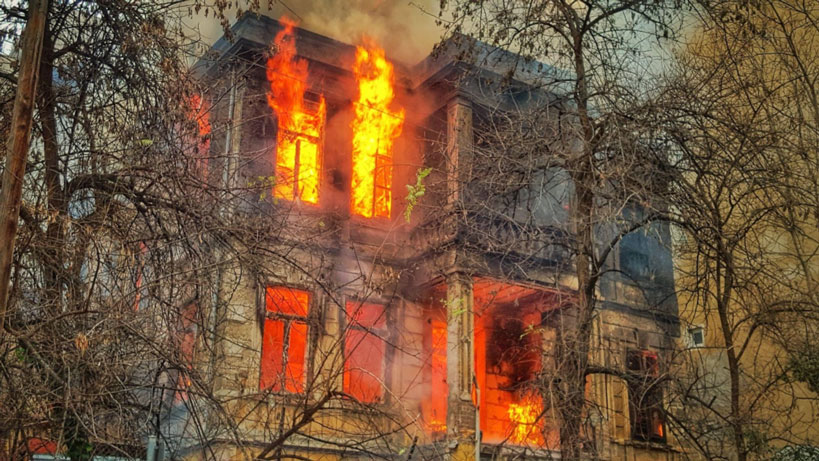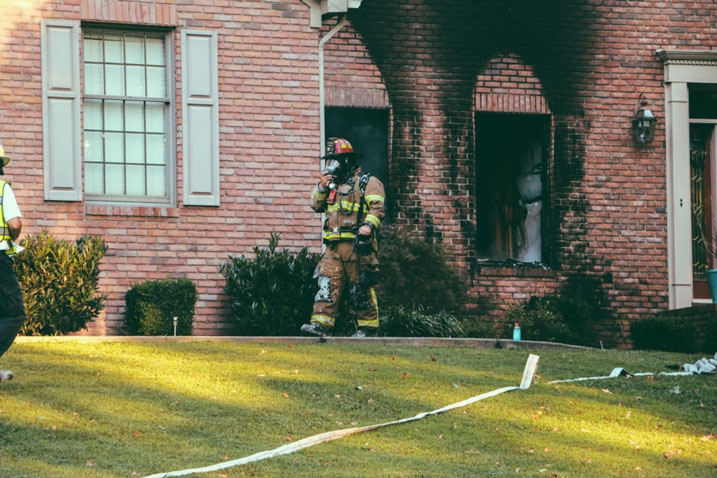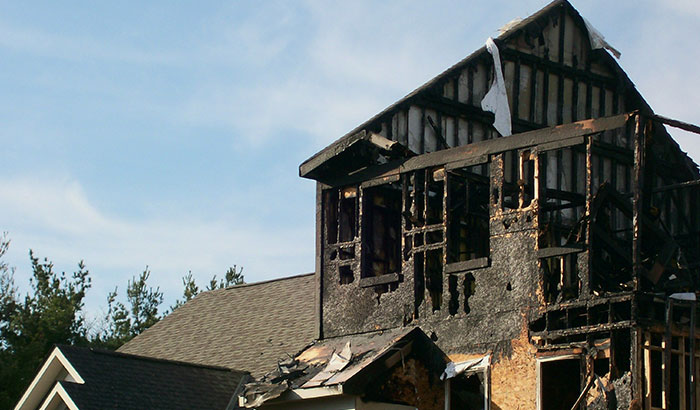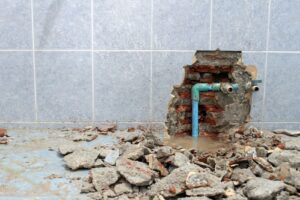Fire damage can profoundly impact properties, leading to destruction, safety hazards, and emotional distress. Therefore, identifying the specific types of fire damage is crucial for effective restoration and insurance purposes.
In this comprehensive guide, we will define fire damage and provide a step-by-step approach to help you identify various types of fire damage. By following these detailed steps, you can gain a comprehensive understanding of the nature and extent of the damage, enabling you to plan for appropriate restoration.
But First, What Is Fire Damage?
Fire damage refers to the destruction, deterioration, or impairment caused by a fire incident. It encompasses various aspects, including structural damage, smoke damage, soot deposition, water damage resulting from firefighting efforts, and other secondary effects. Identifying the specific types of fire damage is essential for accurate assessment, restoration planning, and insurance claims.
Now, on to the Steps:
Step 1: Assess Structural Integrity
Inspect the affected property and look for visible signs of structural damage caused by the fire. Check for collapsed ceilings, charred or weakened walls, or damaged support beams. Note any cracks, warping, or unevenness in the structure, as they may indicate underlying structural damage that requires immediate attention.
Step 2: Evaluate Exterior Damage
Examine the exterior of the building for signs of fire damage. Look for charring, discoloration, or melting of exterior walls, windows, doors, and roofing materials. In addition, pay attention to any structural elements that may have been compromised, such as weakened foundations or compromised structural components.
Step 3: Inspect for Smoke Damage
Smoke damage is a common consequence of a fire. Inspect the affected areas for signs of smoke damage, including black or gray residue on walls, ceilings, furniture, and belongings. Smoke particles can penetrate porous materials and leave behind a distinct odor. Take note of any lingering smoke smells that may require professional deodorization.
Step 4: Identify Soot Deposits
Soot is a black residue left behind by incomplete combustion. Look for soot deposits on walls, ceilings, furniture, and household items. Soot can vary in texture and consistency, ranging from dry and powdery to sticky and greasy. Note the extent of soot deposition, as heavy soot coverage may require specialized cleaning methods.
Step 5: Assess Water Damage
Water damage is often a result of firefighting efforts and can exacerbate the overall damage. Look for signs of water intrusion, such as wet or damp areas, water stains, or discoloration on walls, ceilings, and floors. Pay attention to potential secondary issues, such as mold growth or structural deterioration caused by prolonged moisture exposure.
Step 6: Examine Electrical Systems
Fire incidents can damage electrical systems, posing significant safety hazards. Inspect the electrical wiring, outlets, switches, and panels for visible damage, including melting, charring, or discoloration. Avoid handling electrical components and seek professional assistance to assess and repair the electrical system.
Step 7: Check Plumbing and Water Supply
Fires can cause damage to plumbing systems, leading to leaks, pipe bursts, or water supply disruption. Inspect visible pipes and plumbing fixtures for any signs of damage, such as cracks, corrosion, or leakage. Test faucets, toilets, and other water outlets to ensure proper functionality and assess the need for repairs.
Step 8: Look for Structural Discoloration
Fire can cause discoloration on surfaces, indicating varying degrees of heat exposure. Inspect walls, ceilings, and other structural elements for discoloration, including yellowing, browning, or blackening. The severity of discoloration can give you insights into the intensity of heat generated during the fire and help determine the extent of damage to different areas.
Step 9: Assess Damage to Windows and Doors
Fire can affect windows and doors, compromising their structural integrity and functionality. Inspect windows and doors for visible damage, such as cracks, shattered glass, or warping. Check if they open and close properly, and assess any damage to frames, hinges, or locks.
Step 10: Check for Warping or Buckling of Materials
Intense heat from a fire can cause materials to warp or buckle. Inspect wooden surfaces, such as doors, furniture, or flooring, for signs of damage. Additionally, check laminate or vinyl flooring for any curling or separation from the subfloor. Note the extent of the damage and whether repairs or replacements are necessary.
Step 11: Evaluate Damage to Appliances and Electronics
Fire can cause significant damage to appliances and electronics. Inspect these items for visible signs of damage, such as charring, melting, or scorch marks. Avoid turning on or using damaged appliances or electronics, as they may pose safety hazards and require professional assessment or repair.
Step 12: Look for Odor Absorption
Smoke can permeate porous materials, leading to persistent odors even after visible cleaning. Sniff the air and assess if lingering smoke odors are in the affected areas. Pay attention to areas with heavy smoke exposure, as they may require specialized deodorization techniques to eliminate the odor effectively.

Step 13: Inspect HVAC Systems
Fire incidents can affect heating, ventilation, and air conditioning (HVAC) systems. Inspect HVAC units, ductwork, and filters for visible damage, such as soot accumulation, charring, or warping. It is essential to have a professional HVAC technician assess and clean the system to prevent the circulation of smoke particles or other contaminants.
Step 14: Assess Damage to Insulation
Fire can damage insulation materials, reducing their effectiveness and potentially compromising energy efficiency. Inspect the insulation in walls, ceilings, and attics for visible damage, such as scorch marks, charring, or crumbling. Note areas where insulation may need replacement or additional insulation may be necessary.
Step 15: Examine Fire Suppression System Components
If the property has a fire suppression system, such as sprinklers, examine the components for damage or malfunction. Check for signs of activation, such as water stains or moisture, and assess if the system requires repairs or replacement.
Step 16: Evaluate Landscaping and Exterior Structures
Fire damage may extend beyond the building to surrounding landscaping or exterior structures. Inspect vegetation, trees, fences, sheds, or other outdoor structures for visible fire damage, charring, or destruction. Assess the need for repairs or replacements and consider potential risks, such as unstable trees or weakened structures.
Step 17: Check for Fire Damage to Vehicles
If vehicles were present during the fire, inspect them for visible damage. Look for charring, melted parts, or smoke damage on the exterior and interior surfaces. Assess the extent of the damage and consult with professionals for appropriate repairs or replacements.
Step 18: Assess Damage to Personal Belongings
Survey your personal belongings for damage. Look for signs of fire damage, such as charring, soot, smoke damage, or melting. Pay particular attention to items with sentimental or monetary value, such as photographs, documents, jewelry, or electronics. Document the damage for insurance claims and consult restoration professionals for specialized cleaning or restoration services.
Step 19: Evaluate the Overall Fire Pattern
Examine the fire pattern to understand the direction and intensity of the fire. Look for V-patterns, where the fire traveled upward, or inverted cone patterns, indicating the fire’s origin. These patterns can provide insights into the source of the fire and guide the restoration process.
Step 20: Identify Fire Damage to Chimneys and Fireplaces
Inspect chimneys and fireplaces for signs of fire damage. Check for cracks, spalling, or crumbling bricks or stones. Look for discolored or warped metal components, such as chimney caps or damper assemblies. Assess the integrity of the flue liner and ensure it is intact. A professional should address any damage to the chimney or fireplace before further use.
Step 21: Evaluate Damage to Fire-Resistant Materials
Fire-resistant materials, such as fire-rated walls, doors, or fireproof safes, may exhibit signs of damage even if they have withstood the fire. Inspect these materials for any visible cracks, bulges, or discoloration. Assess their structural integrity and effectiveness in containing the fire. Consult professionals to determine if any repairs or replacements are necessary.
Step 22: Check for Water Contamination
If water was used to extinguish the fire, assess the potential contamination of water sources. Test the water quality for any signs of contamination, such as discoloration, odor, or unusual taste. If water wells or private water sources are present, consult with water testing professionals to ensure the safety of the water supply.
Step 23: Assess Environmental Hazards
Fires can release hazardous substances, such as asbestos or lead, into the air or surrounding environment. If your property was constructed before the ban on asbestos or contains lead-based paint, consider the potential for these hazards. Consult with environmental professionals to conduct testing and determine the presence of these substances.
Step 24: Document the Damage
In the case of severe fire damage, you’ll want to get your insurance involved. Documenting the damage will help you have a fuller understanding of the extent of the damages and will help during the insurance claims process.
Step 25: Seek Professional Consultation
It is essential to consult with professionals specializing in fire damage restoration throughout the identification process. They possess the knowledge and expertise to accurately identify specific types of fire damage. In addition, professionals can provide detailed reports, recommend appropriate restoration methods, and assist with insurance claims. Their guidance will help you navigate the restoration process efficiently and effectively.
Identifying different types of fire damage is a crucial step in the restoration process. Following this comprehensive guide, you can systematically assess the extent of structural damage, smoke damage, soot deposition, water damage, and other associated effects of a fire incident. Remember to prioritize safety during the assessment and consult with professionals whenever necessary. Armed with a thorough understanding of the specific fire damage, you can plan for the appropriate restoration measures and work towards rebuilding and restoring your property.
Dealing with fire damage requires expertise, specialized equipment, and extensive knowledge of restoration techniques. While it may be tempting to tackle the cleanup process on your own, hiring professional fire damage cleanup services is essential for a safe, efficient, and thorough restoration.
Should You Hire a Professional for Fire Damage Restoration?
In this section, we’ll outline the most compelling reasons why leaving fire damage cleanup to professionals is the best course of action.
Expertise and Experience:
Fire damage restoration professionals possess extensive knowledge and experience in dealing with various fire damage scenarios. They understand the complexities of assessing damage, identifying hidden issues, and implementing appropriate restoration strategies.
Safety Considerations:
Fire damage cleanup can be hazardous due to potential structural instability, harmful chemicals, and other safety risks. Professionals are trained in safety protocols, have protective gear, and know how to navigate hazardous environments, minimizing the risk of accidents or injuries.
Efficient Damage Assessment:
Professional fire damage cleanup teams conduct thorough assessments to determine the extent of the damage. They possess the expertise to identify visible and hidden damage, ensuring that no aspect of the restoration process is overlooked.
Prevent Further Damage:
Acting swiftly after a fire incident is crucial to prevent further damage. Professionals can quickly secure the property, board up windows, tarp roofs, and take necessary measures to prevent additional water intrusion, vandalism, or theft.

Specialized Equipment:
Fire damage restoration requires specialized equipment and tools that professionals have at their disposal. This includes industrial-grade dehumidifiers, air movers, ozone machines, thermal imaging cameras, and advanced cleaning agents. These tools enable professionals to effectively remove smoke residue, eliminate odors, and restore the property to its pre-fire condition.
Soot and Smoke Removal:
Soot and smoke residues can be pervasive and challenging to remove. Professionals have the expertise to assess the type of soot and select appropriate cleaning methods to eliminate residues from various surfaces. They utilize specialized techniques such as dry cleaning, wet cleaning, or abrasive cleaning, depending on the materials involved.
Structural Integrity Assessment:
Fire can compromise the structural integrity of a building. Professionals have the knowledge and experience to accurately assess the extent of structural damage. They can identify weakened walls, compromised foundations, or other structural issues that may require immediate attention to ensure the safety of the property.
Water Damage Mitigation:
Water damage is often an inevitable consequence of firefighting efforts. Professionals address fire damage and have the expertise to mitigate water damage effectively. They have the equipment to extract water, dry affected areas, and prevent mold growth or further structural deterioration.
Mold Prevention and Remediation:
Moisture resulting from firefighting efforts can create an ideal environment for mold growth. Professionals employ industry-approved techniques to prevent mold infestation and, if necessary, perform mold remediation to ensure a safe and healthy living environment.
Odor Removal:
Lingering smoke odors can be persistent and challenging to eliminate. Professionals utilize advanced deodorization techniques such as ozone treatment, thermal fogging, or air scrubbing to remove odors and restore indoor air quality.
Contents Restoration:
Fire damage affects not only the structure but also personal belongings and furnishings. Professional restoration companies offer comprehensive content cleaning and restoration services. They have specialized techniques and facilities to clean and restore salvageable items, including furniture, documents, electronics, clothing, and sentimental possessions.
Insurance Documentation and Claims:
Professional fire damage restoration teams have experience working with insurance companies. They can assist in documenting the damage, providing detailed reports, and working closely with insurance adjusters to ensure a smooth and efficient claims process.
Minimize Health Risks:
Fire damage can introduce hazardous environmental substances, such as asbestos or lead-based materials. Professionals are trained to identify and handle such materials safely, minimizing health risks for both the restoration team and the occupants of the property.
Knowledge of Building Codes and Regulations:
Restoring a fire-damaged property often requires compliance with local building codes and regulations. Professionals are well-versed in these requirements and can ensure that the restoration process meets all necessary standards, preventing potential issues or violations.
Faster Restoration Process:
Professionals are equipped with the resources, experience, and manpower to expedite the fire damage restoration process. Their efficiency allows for a faster recovery, minimizing disruption and allowing you to return to a safe and habitable environment promptly.
Document Salvage and Restoration:
Important documents, such as passports, contracts, or legal records, can be severely damaged by fire. Professional restoration companies have specialized methods to salvage and restore fire-damaged documents, helping you recover critical information and minimize losses.
Emotional Support:
Experiencing a fire can be emotionally distressing. Professional fire damage restoration teams understand property owners’ challenges during this difficult time. They provide compassionate support, guidance, and reassurance throughout the restoration process, helping to alleviate stress and restore a sense of normalcy.
Comprehensive Cleaning and Sanitization:
Fire damage goes beyond visible soot and smoke residues. Professionals thoroughly clean and sanitize affected areas, ensuring the removal of bacteria, fungi, and other contaminants that may pose health risks.
Restoration of HVAC Systems:
Fire damage can affect heating, ventilation, and air conditioning (HVAC) systems, spreading smoke particles and odors throughout the property. Professionals have the expertise to clean and restore HVAC systems, ensuring the elimination of contaminants and providing a safe and comfortable indoor environment.
Long-Term Cost Savings:
Although hiring professionals for fire damage cleanup may initially seem like an additional expense, it can lead to long-term cost savings. Professionals address the damage promptly, mitigating further deterioration and preventing the need for more extensive repairs or replacements in the future.
Leaving fire damage cleanup to professionals is a prudent decision for numerous reasons. Their expertise, experience, specialized equipment, and comprehensive restoration services ensure a safe, efficient, and thorough recovery process. By entrusting the restoration to professionals, you can focus on other essential aspects of recovery while knowing that your property is in capable hands.
Utah Disaster Cleanup
Utah Disaster Cleanup has the knowledge and expertise to cleanup any damage in your home or business caused by a fire. If your home or business has experienced fire damage, contact us today, and we will eliminate the damage and return your home to its original condition.



